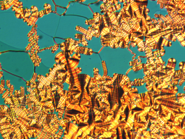Ingo Dierking, featured ILCC liquid crystal artist, June 2013


Jury comment: The oily streak texture, with it's beautifully uniform background punctuated by complex "stringy" features, leading to an "oily" appearance, has been known essentially since the beginning of liquid crystal science, and has been featured in the ILCS picture gallery (see November 2009, September 2010, March 2011). This texture occurs in "lamellar" systems such as thermotropic smectics and cholesterics.
The oily streak texture, beautiful in its seeming simplicity, but structurally complex at the defects leading to the "strings," is seen in cholesteric LCs when the substrate surfaces favor planar alignment, leading to a system where the helix is perpendicular to the substrates. In this LC picture of the month, the LC material possesses positive dielectric anisotropy. Application of an electric field causes the system to convert to a "uniform-lying helix" alignment showing a strongly birefringent texture with complex patterns identical in some places with a typical lamellar focal conic texture, and also including unusual, highly periodic features. As pointed out by this month's photomicroscopic artist, in this image the reorientation nucleates at the oily streaks.
